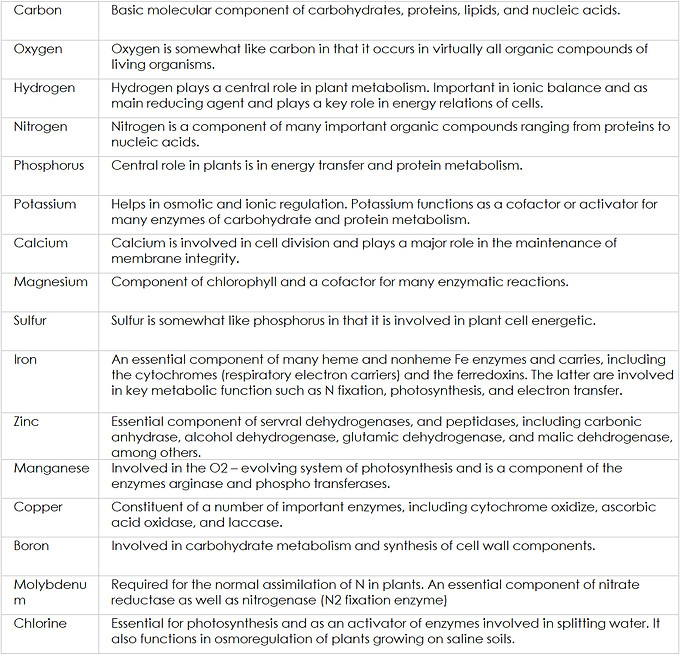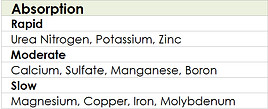
ESSENTIAL ELEMENTS & NUTRIENTS
ELEMENTS
Essentiality of Elements in Plant Nutrition
A mineral element is considered essential to plant growth and development if the element is involved in plant metabolic functions and the plant cannot complete its life cycle without the element. Usually the plant exhibits a visual symptom indicating a deficiency in a specific nutrient, which normally can be corrected or prevented by supplying the nutrient.
Terms commonly used to describe levels of nutrients in plants:
Deficient
When the concentration of essential element is low enough to limit yield severely distinct deficiency symptoms are visible. Extreme deficiencies can result in plant death. With moderate or slight deficiencies, symptoms may not be visible, but yields will still be reduced.
Critical Range
The nutrient concentration in the plant below which a yield response to added nutrient occurs. Critical levels or ranges vary among plants and nutrients, but occur somewhere in the transition between nutrient deficiency and sufficiency
Sufficient
The nutrient concentration range in which added nutrient will not increase yield but can increase nutrient concentration.
The term luxury consumption
is often used to describe nutrient absorptionby the plant that does not influence yield.
Excessive or toxic
When the concentration of essential or other elements
is high enough to reduce plant growth and yield. Excessive nutrient concentration
can cause an imbalance in other essential nutrients, which also can reduce yield.
Essential Elements
Sixteen elements are considered essential to plant growth. Carbon (C), hydrogen (H) and oxygen (O) are the most abundant elements in plants. The photosynthetic process in green leaves converts CO2 and H2O into simple carbohydrates from which amino acids, sugars, proteins, nucleic acid and other organic compounds are synthesized. Carbon, H and O are not considered mineral nutrients. The supply of CO2 is relatively constant. The supply of H2O rarely limits photosynthesis directly but does indirectly though the various effects resulting from moisture stress.
The remaining 13 essential elements are classified as macronutrients and micronutrients and the classification is based on their relative abundancein plants. The macronutrients are nitrogen (N), phosphorus (P), potassium (K),sulfur (S), calcium (Ca) and magnesium (Mg). Compared to the macronutrients, the concentrations of the seven micronutrients – iron (Fe), zinc (Zn), manganese (Mn), copper (Cu), born (B), chlorine (Cl) and molybdenum (Mo) are very small.
Five additional elements – sodium (Na), cobalt (Co), vanadium (Va), nickel (Ni) and silicon (Si) have been established as essential micronutrients in some plants. Micronutrients are often referred to as minor elements, but this does not mean that they are less important than macro nutrients. Micronutrient deficiency or toxicity can reduce plant yield similar to macronutrient deficiency or toxicity.
In fact, plants absorb many nonessential elements, and over 60 elements have been identified in plant materials. When plant material is burned the remaining plant ash contains all the essential and nonessential mineral elements except,
C, H, O, N and S which are burnt off as gases.
Soil, climate, crop variety and management factors exert considerable influence on plant composition. Because many biological and chemical reactions occur with fertilizers in soils,
the quantity of nutrients absorbed by plants does not equal the quantity applied as a fertilizer. Proper fertilizer management can maximize the proportion of fertilizer nutrient absorbed by the plant. As plants absorb nutrients from the soil, complete their life cycle and die, the nutrients in the plant residue are returned to the soil. These plant nutrients are subject to the same biological and chemical reactions as fertilizer nutrients.

Functions of Essential Nutrients in Plants


General absorption and mobility rankings



